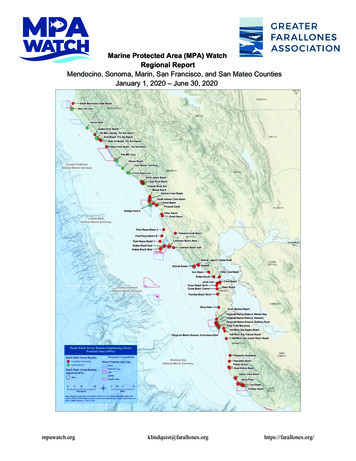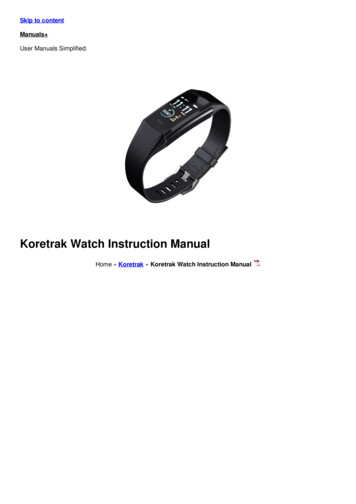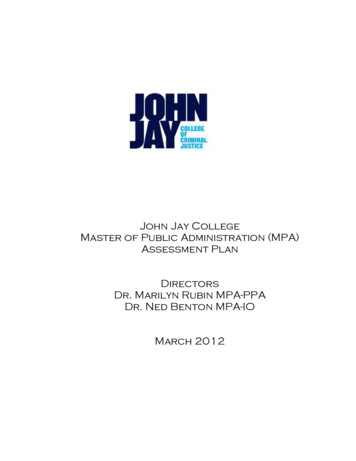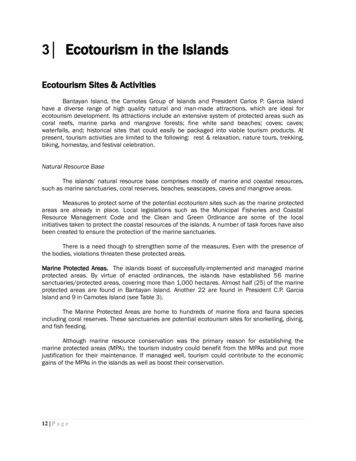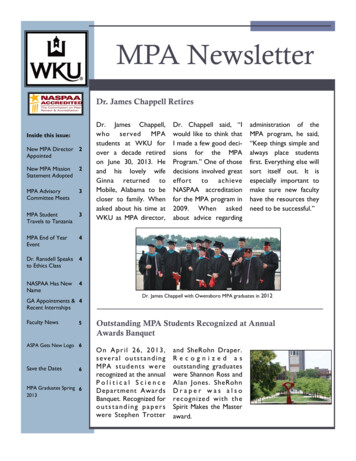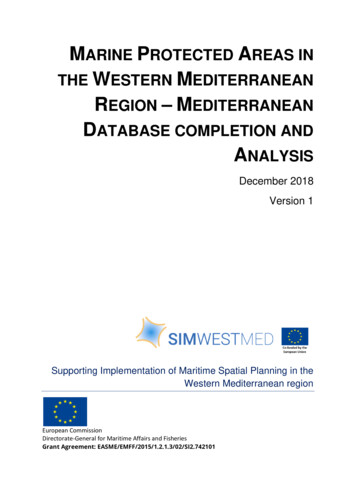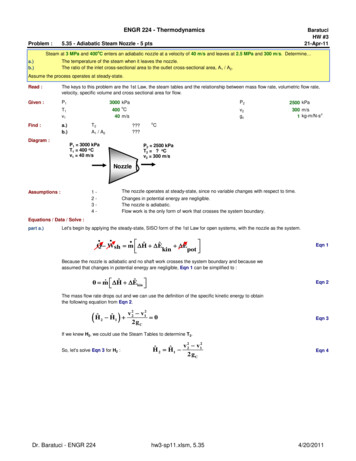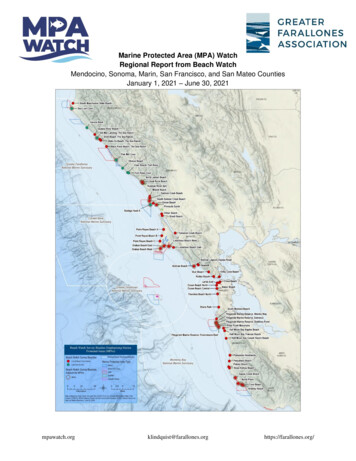
Transcription
Marine Protected Area (MPA) WatchRegional Report from Beach WatchMendocino, Sonoma, Marin, San Francisco, and San Mateo CountiesJanuary 1, 2021 – June 30, arallones.org/
MPA Watch is a statewide collaborative effort to collect critical human use data toenhance the management and conservation of marine protected areas (MPAs). MPAWatch data informs the management, enforcement, and science of California's MPAsand allows us insight on how human uses are changing as a result of MPAimplementation. By involving local communities in this important work, MPA Watchprograms inspire and empower stewardship, and educate California communities aboutocean ecosystems. MPA Watch trains volunteers to observe and collect unbiased dataon coastal and marine resource use. The North-central Coast Marine Protected Area(MPA) Watch Program, organized by Greater Farallones Association’s Beach Watchprogram, engages 150 community scientists in 10 MPAs, spanning 5 counties.North Central California MPA Watch ReportJanuary 1, 2021 – June 30, 2021Page 2
Human Use of MPAs January - June 2021MPAs by All ActivityJanuary 1, 2021 - June 30, 20211,146 EventsBodega Head SMR - 202 (18%)Russian River SMRMA- 175 (15%)Del Mar Landing SMR - 139 (12%)Montara SMR- 142 (12%)Año Nuevo SMCA - 113 (10%)Estero de Limantour SMR - 113 (10%)Sea Lion Cove SMCA - 107 (9%)Russian River SMCA - 90 (8%)Point Reyes SMR - 65 (6%)Stewarts Point SMR - 0 ( 1%)OverviewNorth Central California MPA Watch ReportJanuary 1, 2021 – June 30, 2021Page 3
Activity by MPAActivity ClassificationsOn-Shore - Activities that take place on a sandy or rocky beach. Excludes bluffs, trails, sea walls,parking lots, or other man-made structures. Includes recreation, tidepooling, shore-based fishing, etc.Off-Shore - Activities that take place offshore, typically in knee-deep water or deeper. Includes surfing,SCUBA diving, kayaking, boat fishing, etc.Consumptive - An activity in which a natural resource (i.e. fish, kelp, shells) is being collected.Non-Consumptive - An activity in which a natural resource is not collected.North Central California MPA Watch ReportJanuary 1, 2021 – June 30, 2021Page 4
North Central California MPA Watch ReportJanuary 1, 2021 – June 30, 2021Page 5
Activity Incidence by MPAThe charts below show incidence values for each MPA monitored by Greater Farallones AssociationBeach Watch program. Incidence is calculated as number of activities recorded divided by totalsurvey-miles.On Shore, Non-ConsumptiveJanuary 1- June 30, All YearsJanuary 1, 2021 - June 30, 202150.0040.0030.0020.0010.000.00Sea Lion Del Mar StewartsCove SMCA Landing Point SMRSMRRussianRiverSMCARussianRiverSMRMABodega Estero dePointMontara Año NuevoHead SMR Limantour Reyes SMRSMRSMCASMROn Shore, ConsumptiveJanuary 1- June 30, All YearsJanuary 1, 2021- June 30, 20210.400.350.300.250.200.150.100.050.00Sea LionCove SMCADel MarLandingSMRStewartsRussianRussianPoint SMR River SMCA RiverSMRMANorth Central California MPA Watch ReportJanuary 1, 2021 – June 30, 2021Page 6BodegaEstero de Point Reyes Montara Año NuevoHead SMR LimantourSMRSMRSMCASMR
Offshore, Non-ConsumptiveJanuary 1- June 30, All YearsJanuary 1, 2021- June 30, 202114.0012.0010.008.006.004.002.000.00Sea LionCoveSMCADel Mar Stewarts RussianLanding Point SMR RiverSMRSMCARussian Bodega Estero deRiver Head SMR MCAOffshore, ConsumptiveJanuary 1- June 30, All YearsJanuary 1, 2021- June 30, 20210.350.300.250.200.150.100.050.00Sea LionCoveSMCADel Mar Stewarts RussianLanding Point SMR RiverSMRSMCANorth Central California MPA Watch ReportJanuary 1, 2021 – June 30, 2021Page 7RussianBodega Estero dePointMontara Año NuevoRiver Head SMR Limantour Reyes SMR SMRSMCASMRMASMR
Activity Incidence by MPANorth Central California MPA Watch ReportJanuary 1, 2021 – June 30, 2021Page 8
Notes on Calculating IncidenceThe baseline rate for the reporting period was calculated by summing the total use count for each categoryduring the same period from each previous year and dividing this value by the transect miles surveyed ateach site. The miles surveyed were calculated by first identifying the length of each transect for all the MPA’sin question and multiplying the length of the transect by the number of surveys that had been taken alongthat transect during the same time period. For MPA’s with multiple transects, the total distance traveled foreach transect within the MPA were summed together to get the total miles surveyed within that MPA.Breakdown by MPASea Lion Cove State Marine Conservation AreaBetween the months of January and June 2021, GFA’s MPA Watch data suggests arate of 6.08 total uses per mile surveyed in this MPA. This is an increase compared tothe baseline data rate (2014-2020). People observed in the MPA were primarily takingpart in non-consumptive activities both on and off-shore, such as beach and oceanrecreation. This accounted for almost 100% of the activities logged in the MPA Watchsurveys. Less than 1% of human use was comprised of onshore consumptive activities,a decrease of 100%.Del Mar Landing State Marine ReserveBetween the months of January and June 2021, GFA’s MPA Watch data suggests arate of 19.86 total uses per mile surveyed in this MPA. This is a large increasecompared to the baseline data rate (2014-2020). People observed in the MPA wereprimarily taking part in non-consumptive activities onshore, such as beach recreation.This accounted for almost 100% of the activities logged in the MPA Watch surveys.Less than 1% of human use was comprised of onshore consumptive activities.Stewarts Point State Marine ReserveBetween the months of January and June 2021 data was collected at some sites,however it has not been entered.Russian River State Marine Conservation AreaBetween the months of January and June 2021, GFA’s MPA Watch data suggests arate of 14.06 total uses per mile surveyed in this MPA. This is a decrease compared tothe baseline data rate (2014-2020). 96% of people observed in the MPA were takingpart in non-consumptive activities on-shore, such as beach recreation. Less than 4%human use was comprised of both onshore (3%) and off-shore (1%) consumptiveactivities.Russian River State Marine Recreational Management AreaNorth Central California MPA Watch ReportJanuary 1, 2021 – June 30, 2021Page 9
Between the months of January and June 2021, GFA’s MPA Watch data suggests arate of 58.33 total uses per mile surveyed in this MPA. This is a 45% increasecompared to the baseline data rate (2014-2020). 100% of people observed in the MPAwere taking part in non-consumptive activities both on (77%) and off-shore (23%), suchas beach and ocean recreation.Bodega Head State Marine ReserveBetween the months of January and June 2021, GFA’s MPA Watch data suggests arate of 14.23 total uses per mile surveyed in this MPA. This is a decrease compared tothe baseline data rate (2014-2020). People observed in the MPA were primarily takingpart in non-consumptive activities both on and off-shore, such as beach and oceanrecreation. This accounted for almost 97% of the activities logged in the MPA Watchsurveys. Less than 3% of human use was comprised of onshore and off-shoreconsumptive activities.Estero de Limantour State Marine ReserveBetween the months of January and June 2021, GFA’s MPA Watch data suggests arate of 4.28 total uses per mile surveyed in this MPA. This is a 25% increase comparedto the baseline data rate (2014-2020). People observed in the MPA were primarilytaking part in non-consumptive activities both on and off-shore, such as beach andocean recreation. This accounted for almost 96% of the activities logged in the MPAWatch surveys. Less than 4% of human use was comprised of consumptive activities.Point Reyes State Marine ReserveBetween the months of January and June 2021, GFA’s MPA Watch data suggests arate of 3.35 total uses per mile surveyed in this MPA. This is a decrease compared tothe baseline data rate (2014-2020), which may be due to several Federal Park Closuresin 2020. People observed in the MPA were primarily taking part in non-consumptiveactivities both on and off-shore, such as beach and ocean recreation. This accountedfor almost 98% of the activities logged in the MPA Watch surveys. Less than 2% ofhuman use was comprised of consumptive activities.Montara State Marine ReserveBetween the months of January and June 2021, GFA’s MPA Watch data suggests arate of 9.59 total uses per mile surveyed in this MPA. This is a 78% decrease comparedto the baseline data rate (2014-2020). People observed in the MPA were primarilytaking part in non-consumptive activities both on and off-shore, such as beach andocean recreation. This accounted for 100% of the activities logged in the MPA Watchsurveys. There were no consumptive activities recorded.North Central California MPA Watch ReportJanuary 1, 2021 – June 30, 2021Page 10
Año Nuevo State Marine Conservation Area between the months of January andJune 2021, GFA’s MPA Watch data suggests a rate of 8.37 total uses per mile surveyedin this MPA. People observed in the MPA were primarily taking part in non-consumptiveactivities on shore, this accounted for almost 100% of the activities logged in the MPAWatch surveys. However we observed an increase in offshore non-consumptiveactivities.Next StepsGreater Farallones Association intends to expand the volunteer pool in the Sonoma andMendocino region in 2021. Increasing our knowledge in this remote region strugglingwith severe Abalone declines. MPA Watch intends to collaborate with the CaliforniaDepartment of Fish and Wildlife (CDFW) to distribute MPA Watch reports to regionalmanagers in order to improve the management and enforcement of MPAs. MPA Watchis also looking to expand its network of partner organizations to enhance the scale andscope of MPA monitoring across California. MPA Watch will be making our human usedata available on our website to make it accessible to partners, resource agencies,municipalities, and other interested parties. One of the hopes of MPA Watch is thatvolunteers and community members help spread knowledge and awareness of MPAs tothe communities that surround them, inspiring marine stewardship in our populations.Additional InformationFor additional information on MPA Watch, including survey sites, participatingorganizations, protocols and datasheets, media kit, and how to get involved, pleasevisit mpawatch.org. Connect with MPA Watch on social media @MPAWatchOrg.For additional information regarding MPAs and regulations specific to the variousclassifications of MPAs please visit wildlife.ca.gov/MPAs. If you see an activity thatviolates MPA regulations, please call CalTip to report the violation at (888)-334-2258.For more information about the work the Greater Farallones Association does toconserve California’s Federal and California MPAs and other conservation projectsplease visit farallones.org.North Central California MPA Watch ReportJanuary 1, 2021 – June 30, 2021Page 11
Marine Protected Area (MPA) Watch . Mendocino, Sonoma, Marin, San Francisco, and San Mateo Counties January 1, 2021 - June 30, 2021 . North Central California MPA Watch Report January 1, 2021 - June 30, 2021 Page 2 MPA Watch is a statewide collaborative effort to collect critical human use data to
